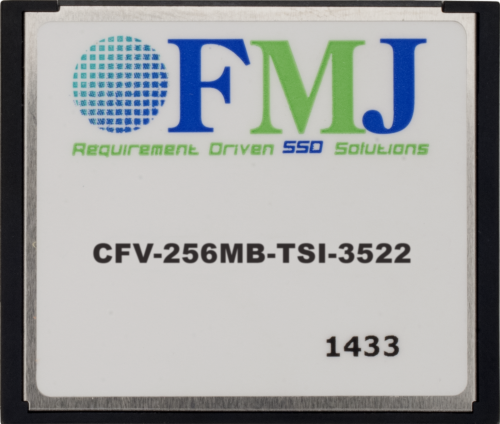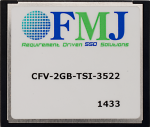
Overview
The CFMC256M is a 256 MB, industrial-grade CompactFlash card that has been selected specifically to provide optimum performance and extreme reliability. It is used with the CFM100, NL115, NL116, or CF1 to expand a data logger's memory and to transport data, camera images, programs, and operating systems without having to use a PC.
Read MoreBenefits and Features
- Integrated wear-leveling and ECC technology
Images

Similar Products
Detailed Description
A PC can read/write data stored on the CFMC256M by using either the CF1 CompactFlash adapter or the 17752 Reader/Writer.
Specifications
| Manufacturer | FMJ |
| Card Type | Industry standard Type I CF form factor |
| Storage Capacity | 256 MB |
| Card Format | FAT32 |
| Temperature Range |
|
| Compliance | RoHS compliant |
| Dimensions | 4.28 x 3.64 x 0.33 cm (1.69 x 1.43 x 0.13 in.) |
| Weight | 10 g (0.35 oz) |
Compatibility
Note: The following shows notable compatibility information. It is not a comprehensive list of all compatible or incompatible products.
Data Loggers
| Product | Compatible | Note |
|---|---|---|
| 21X (retired) | ||
| CR10 (retired) | ||
| CR1000 (retired) | ||
| CR10X (retired) | ||
| CR200X (retired) | ||
| CR206X (retired) | ||
| CR211X (retired) | ||
| CR216X (retired) | ||
| CR23X (retired) | ||
| CR295X (retired) | ||
| CR3000 (retired) | ||
| CR500 (retired) | ||
| CR5000 (retired) | ||
| CR510 (retired) | ||
| CR800 (retired) | ||
| CR850 (retired) | ||
| CR9000 (retired) | The CR9000 requires a CR9080 PAM module. | |
| CR9000X (retired) |
Additional Compatibility Information
Card Format
Currently, the CFMC256M is formatted as FAT32; our contemporary data loggers require this format for the card to work as expected. Cards purchased before August 2008 were formatted as FAT16. Our CC640 camera (retired), the CR9000 dataloggers (retired), and CR5000 dataloggers with older operating systems need the FAT16 format. A card formatted as FAT32 can be reformatted as FAT16.
Documents
Brochures
Frequently Asked Questions
Number of FAQs related to CFMC256M: 6
Expand AllCollapse All
-
With OS 7 or greater and the TableFile() instruction with Option 64, CompactFlash cards greater than 2 GB can be used. For more information, see the “A Better Way to Write High-Frequency Data to 16 GB and Smaller CF Cards” application note.
-
Save the data to a CompactFlash card. Transfer the data from the CR5000 to the PC by removing the card from the CR5000 and inserting it into the PC.
-
Using the FileControl() instruction, the .dat files can be retrieved directly from the memory card. When data is collected by the standard method (not as downloaded files, but as streamed data) with a GetData() or similar instruction, the memory card is automatically used as a source of records to be returned when the internal CPU table no longer contains the oldest data. These records can be retrieved simply by using their record numbers.
-
With operating system 25 or greater, the CR3000 works with CF cards in sizes up to 16 GB using the TableFile() instruction and TFOption 64. For earlier versions of the operating system, the largest compatible CF card size is 2 GB.
For more information, see the “A Better Way to Write High-Frequency Data to 16 GB and Smaller CF Cards” application note.
-
The most reliable method of formatting a CompactFlash (CF) card is to format it using a PC and specifying FAT32.
Articles and Press Releases
Newsletter Articles
Listed Under
Privacy Policy Update
We've updated our privacy policy. Learn More
Cookie Consent
Update your cookie preferences. Update Cookie Preferences
